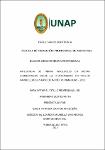Influencia de fibras insolubles en dietas alimenticias sobre la performance en pollos parrilleros en fase de inicio Yurimaguas-2018
Abstract
El trabajo de Investigación se realizó con el propósito de evaluar la influencia de
fibras insolubles en dietas alimenticias sobre la performance en pollos parrilleros
en fase de inicio, en Yurimaguas. Los parámetros evaluados fueron: consumo de
alimento, incremento de peso, conversión alimenticia, índice de mortalidad y el
mérito económico, en 96 pollos machos de la línea Cobb 500, de un día de edad,
empleando el Diseño Estadístico Completamente al Azar (DCA), con tres
tratamientos y cuatro repeticiones, y un grado de confiabilidad (P<0.05). Los
tratamientos fueron: T0 (Tratamiento testigo) 0.0% de fibra insoluble; T1: 0.25% de
afrecho de castaña y T2: 0.30% de afrecho de castaña. Se obtuvo los resultados: para
el consumo acumulado de alimento: 1021.01; 1073.93; 1069.88 g en los
tratamientos T0, T1 y T2 respectivamente, observando diferencias estadísticas
significativas entre tratamientos (P < 0.05)). Con respecto al incremento de peso
acumulado los valores encontrados fueron: T0: 429.45, T1: 497.28 y T2: 519.40 g.
Se encontró diferencias estadísticas significativas (P < 0.05) entre tratamientos:
Asimismo, en la conversión alimenticia acumulada se obtuvieron los valores de:
3.00; 2.81 y 2.70 para los tratamientos T0, T1 y T2, correspondientemente, no
encontrándose diferencias estadísticas significativas entre tratamientos (P < 0.05).
En cuanto al índice de mortalidad, los T2 y T1 no registraron mortalidad, mientras
que el T0: 2,08 %. El mayor mérito económico logrado fue en el T2, mostrando una
mejor rentabilidad con un valor de S/ 1,12. The research work was carried out with the purpose of evaluating the influence of
insoluble fibers in diets on performance in broiler chickens in the start phase, in
Yurimaguas. The parameters evaluated were: feed consumption, weight gain, feed
conversion, mortality rate and economic merit, in 96 male chicks of the Cobb 500
line, one day old, using the Fully Random Statistical Design (DCA) , with three
treatments and four repetitions, and a grade of reliability (P <0.05). The treatments
were: T0 (control treatment) 0.0% insoluble fiber; T1: 0.25% of chestnut bran and
T2: 0.30% of chestnut bran. The results were obtained: for cumulative food
consumption: 1021.01; 1073.93; 1069.88 g in the treatments T0, T1 and T2
respectively, observing significant statistical differences between treatments (P
<0.05)). With respect to the accumulated weight increase, the values found were:
T0: 429.45, T1: 497.28 and T2: 519.40 g. Significant statistical differences were
found (P <0.05) between treatments: Likewise, in the cumulative feed conversion,
the values of: 3.00; 2.81 and 2.70 for treatments T0, T1 and T2, correspondingly, no
significant statistical differences were found between treatments (P <0.05).
Regarding the mortality rate, T2 and T1 did not register mortality, while T0: 2.08%.
The greatest economic merit achieved was in T2, showing a better profitability with
a value of S / 1.12.
Collections
The following license files are associated with this item:


